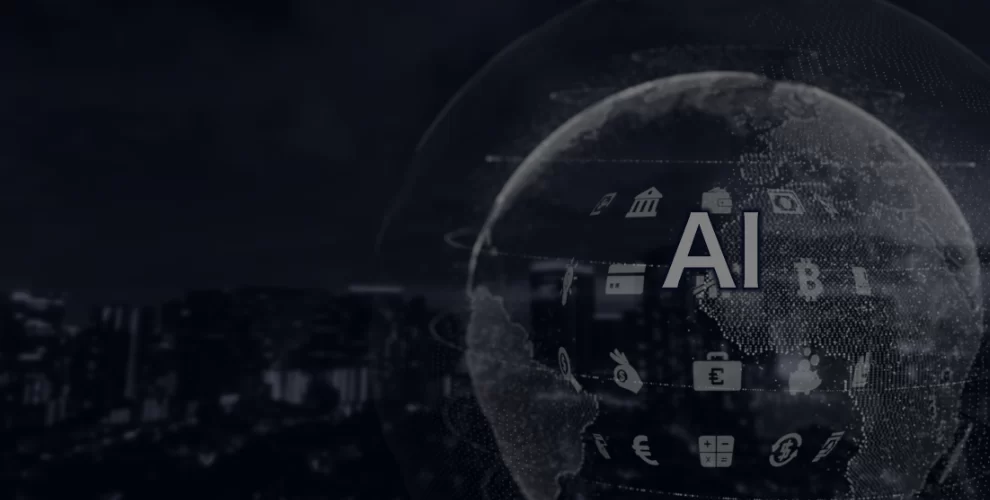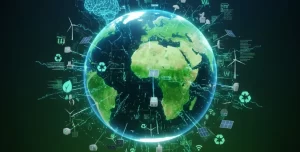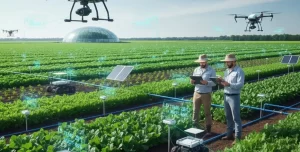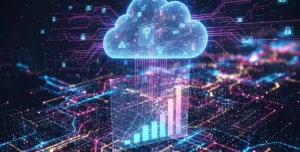
What Are the Sustainable Development Goals and How AI Can Help Achieve Them?
Table of Contents
Introduction
Welcome to WikiGlitz! The Sustainable Development Goals (SDGs) are a global initiative aimed at creating a more sustainable, equitable, and prosperous world by 2030.
These 17 goals address critical issues such as poverty, hunger, health, education, and climate change. In this guide, we will explore each SDG and how artificial intelligence (AI) can play a pivotal role in achieving these ambitious targets.
Key Takeaways
- AI can significantly enhance efforts to achieve the Sustainable Development Goals by providing innovative solutions.
- Each SDG can benefit from AI applications, from healthcare and education to environmental conservation and economic growth.
- Ethical and equitable AI deployment is crucial to ensure that the benefits of AI are accessible to all.
Understanding the Sustainable Development Goals (SDGs)
Definition and Background of SDGs
The Sustainable Development Goals (SDGs) were adopted by all United Nations Member States in 2015 as part of the 2030 Agenda for Sustainable Development. The 17 SDGs are designed to address a broad range of global challenges, including poverty, inequality, climate change, environmental degradation, peace, and justice.
List of the 17 SDGs and Their Key Objectives
- No Poverty: End poverty everywhere.
- Zero Hunger: End hunger, achieve food security, and promote sustainable agriculture.
- Good Health: Ensure healthy lives for all.
- Quality Education: Ensure quality education and learning opportunities.
- Gender Equality: Achieve gender equality and empower all women and girls.
- Clean Water & Sanitation: Ensure water and sanitation for all.
- Affordable & Clean Energy: Ensure access to affordable and modern energy.
- Economic Growth: Promote productive employment & decent work.
- Industry & Infrastructure: Build infrastructure, promote industrialization.
- Reduced Inequality: Reduce inequality within and among countries.
- Sustainable Communities: Ensure cities safe and sustainable.
- Responsible Consumption and Production: Ensure sustainable consumption and production patterns.
- Climate Action: Take urgent action to combat climate change and its impacts.
- Life Below Water: Protect and use marine resources and the oceans and seas responsibly for sustainable development.
- Life on Land: Stop, reverse, and encourage the sustainable use of terrestrial ecosystems; manage forests sustainably; fight desertification; and stop the loss of biodiversity.
- Build inclusive, accountable, and effective institutions at all levels: Encourage peaceful and inclusive societies for sustainable development. Ensure that everyone has access to justice.
- Partnerships for the Goals: Bolster the Global Partnership for Sustainable Development’s implementation strategies and resurrect it.
Role of AI in Achieving SDGs
Overview of AI Technologies
AI encompasses a range of technologies including machine learning, natural language processing, computer vision, and robotics. These technologies can process large amounts of data, identify patterns, and make predictions, thus providing innovative solutions to complex problems.
Potential of AI to Address Global Challenges
AI can significantly accelerate progress towards achieving the SDGs by optimizing resources, improving efficiency, and enabling data-driven decision-making. AI applications can enhance healthcare, increase agricultural productivity, manage energy consumption, and much more.
AI Applications for Each SDG
No Poverty
- AI in Financial Inclusion: AI can analyze financial behaviors to provide credit scores for the unbanked, enabling access to financial services.
- Predictive Analytics for Poverty Reduction: AI models can predict areas at risk of poverty, allowing for targeted interventions.
Zero Hunger
- AI in Agriculture for Food Security: AI can optimize crop yields through precision farming techniques.
- Precision Farming and Crop Monitoring: AI-driven drones and sensors monitor crop health and soil conditions.
Good Health and Well-Being
- AI in Healthcare Diagnostics and Treatment: AI algorithms can diagnose diseases and suggest treatments faster and more accurately than traditional methods.
- Remote Health Monitoring and Telemedicine: AI-powered apps and devices enable remote monitoring of patients and virtual consultations.
Quality Education
- AI-Driven Personalized Learning: AI can create customized learning plans tailored to individual student needs.
- Access to Education through AI Platforms: AI-powered platforms provide educational resources to remote and underserved areas.
Gender Equality
- AI for Monitoring and Promoting Gender Equality: AI can analyze gender representation in media and workplaces.
- Analyzing Gender Data for Policy-Making: AI helps in gathering and analyzing data to inform policies that promote gender equality.
Clean Water and Sanitation
- AI in Water Resource Management: AI optimizes the use of water resources and predicts shortages.
- Predictive Maintenance of Water Systems: AI monitors water infrastructure to predict and prevent failures.
Affordable and Clean Energy
- AI in Optimizing Renewable Energy Sources: AI maximizes the efficiency of solar panels and wind turbines.
- Energy Consumption Monitoring and Management: AI systems reduce energy waste by optimizing usage patterns.
8. Decent Work and Economic Growth
- AI in Job Matching and Skills Development: AI platforms match job seekers with employers based on skills and experience.
- Automation and Economic Productivity: AI-driven automation increases productivity and creates new economic opportunities.
Industry, Innovation, and Infrastructure
- AI in Smart Infrastructure Development: AI designs and manages smart cities and infrastructure projects.
- Enhancing Industrial Processes with AI: AI improves manufacturing processes through predictive maintenance and quality control.
Reduced Inequality
- AI in Social Services and Support: AI systems identify individuals in need and allocate resources efficiently.
- Predictive Models for Identifying Inequalities: AI analyzes data to highlight areas of social and economic inequality.
Sustainable Cities and Communities
- AI for Urban Planning and Smart Cities: AI optimizes urban planning to reduce congestion and improve living conditions.
- Waste Management and Pollution Control: AI monitors waste and pollution levels, optimizing waste collection routes.
Responsible Consumption and Production
- AI in Supply Chain Optimization: AI improves supply chain efficiency, reducing waste and ensuring sustainable sourcing.
- Reducing Waste through AI Technologies: AI systems track and minimize waste in production processes.
Climate Action
- AI in Climate Modeling and Prediction: AI models predict climate change impacts, helping to develop mitigation strategies.
- Disaster Response and Management: AI aids in disaster prediction and coordinates emergency responses.
Life Below Water
- AI in Marine Conservation: AI monitors marine life and identifies threats to ocean ecosystems.
- Monitoring Ocean Health with AI: AI tracks water quality and ocean health indicators.
Life on Land
- AI in Wildlife Conservation: AI-powered cameras and sensors monitor wildlife and detect poaching activities.
- Forest Management and Biodiversity: AI analyzes forest data to promote sustainable management and conservation.
Peace, Justice, and Strong Institutions
- AI for Transparent Governance: AI enhances transparency and accountability in government operations.
- Crime Prediction and Prevention: AI models predict crime patterns, aiding in prevention and law enforcement.
Partnerships for the Goals
- AI in Fostering Global Partnerships: AI platforms facilitate collaboration among international organizations and stakeholders.
- Collaborative Platforms for SDG Initiatives: AI-driven platforms support global efforts to achieve SDGs.
Challenges and Ethical Considerations in AI for SDGs
Data Privacy and Security Concerns
AI relies on vast amounts of data, raising concerns about privacy and data security.
Ensuring Equitable Access to AI Technologies
It is essential to ensure that AI technologies are accessible to all, including marginalized communities, to prevent widening the digital divide.
Addressing AI Biases and Ensuring Fairness
AI systems can inherit biases present in their training data.
Future Trends in AI for Sustainability
Emerging AI Technologies for Sustainable Development
New AI technologies are continuously being developed, offering innovative solutions to sustainability challenges.
Case Studies of Successful AI-Driven SDG Projects
- Google AI for Social Good: Initiatives that use AI to tackle global challenges, such as flood prediction and wildlife conservation.
- IBM’s Call for Code: A global competition encouraging developers to create AI solutions for disaster response and climate change.
Conclusion
WikiGlitz has brought you this comprehensive guide on the Sustainable Development Goals (SDGs) and how AI can help achieve them. By leveraging AI technologies, we can address some of the world’s most pressing challenges and work towards a more sustainable and equitable future. Embrace the power of AI to make a positive impact and contribute to achieving the SDGs.
FAQs
How can AI help achieve SDGs?
AI can optimize resources, improve efficiency, and provide innovative solutions to address challenges related to health, education, energy, environment, and more.
What are some examples of AI applications in sustainability?
Examples include AI in precision farming, renewable energy optimization, healthcare diagnostics, climate modeling, and smart urban planning.
What are the challenges in using AI for SDGs?
Challenges include data privacy concerns, ensuring equitable access to AI technologies, and addressing biases in AI systems.
How can we ensure AI technologies are used ethically and equitably?
Implementing robust data protection measures, promoting transparency, and ensuring inclusive access to AI technologies are essential for ethical and equitable AI deployment.
Want to keep up with our blog?
Our most valuable tips right inside your inbox, once per month.
Error: Contact form not found.
WikiGlitz Team
Welcome to WikiGlitz, your ultimate destination for tech insights and innovation. Our expert team is dedicated to delivering free resources and professional advice on various technology topics, including Artificial Intelligence, Cyber Security, Cloud Computing, and more. We strive to empower our readers with up-to-date information and practical guidance, ensuring you stay ahead in the rapidly evolving tech landscape. At WikiGlitz, we are passionate about making complex technology accessible to everyone. Our team of seasoned experts curates content that is both informative and engaging, helping you understand and leverage the latest tech trends. Whether you're a tech enthusiast or a professional, WikiGlitz is your go-to source for reliable, expert-driven content. Join us on this journey to explore and embrace the future of technology.





